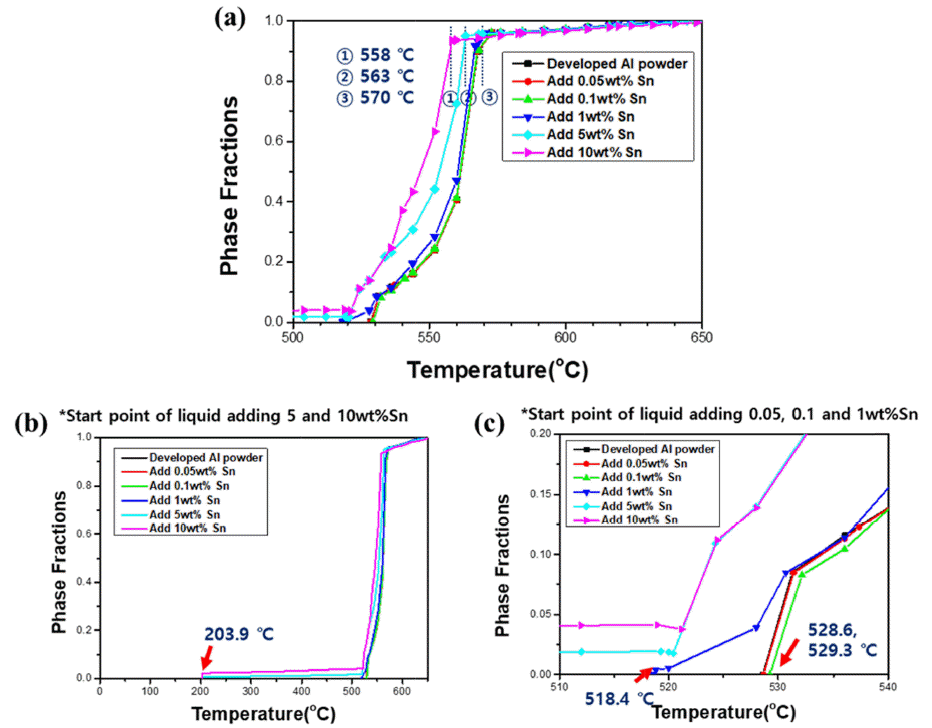Search
- Page Path
- HOME > Search
- [Korean]
- Effect of Sn Addition on Microstructure of Al Alloy Powder for Brazing Process
- Yong-Ho Kim, Hyo-Sang Yoo, Sang-Su Na, Hyeon-Taek Son
- J Korean Powder Metall Inst. 2020;27(2):139-145. Published online April 1, 2020
- DOI: https://doi.org/10.4150/KPMI.2020.27.2.139

- 575 View
- 2 Download
-
 Abstract
Abstract
 PDF
PDF The powder manufacturing process using the gas atomizer process is easy for mass production, has a fine powder particle size, and has excellent mechanical properties compared to the existing casting process, so it can be applied to various industries such as automobiles, electronic devices, aviation, and 3D printers. In this study, a modified A4032-xSn (x = 0, 1, 3, 5, and 10 wt.%) alloy with low melting point properties is investigated. After maintaining an argon (Ar) gas atmosphere, the main crucible is tilted; containing molten metal at 1,000°C by melting the master alloy at a high frequency, and Ar gas is sprayed at 10 bar gas pressure after the molten metal inflow to the tundish crucible, which is maintained at 800°C. The manufactured powder is measured using a particle size analyzer, and FESEM is used to observe the shape and surface of the alloy powder. DSC is performed to investigate the change in shape, according to the melting point and temperature change. The microstructure of added tin (Sn) was observed by heat treatment at 575°C for 10 min. As the content of Sn increased, the volume fraction increased to 1.1, 3.1, 6.4, and 10.9%.
- [English]
- Optimization of Spark Plasma Sintering Temperature Conditions for Enhancement of Thermoelectric Performance in Gas-Atomized Bi0.5Sb1.5Te3 Compound
- Kwang-yong Jeong, Chul Hee Lee, Peyala Dharmaiah, Soon-Jik Hong
- J Korean Powder Metall Inst. 2017;24(2):108-114. Published online April 1, 2017
- DOI: https://doi.org/10.4150/KPMI.2017.24.2.108

- 1,044 View
- 8 Download
- 3 Citations
-
 Abstract
Abstract
 PDF
PDF We fabricate fine (<20 μm) powders of Bi0.5Sb1.5Te3 alloys using a large-scale production method and subsequently consolidate them at temperatures of 573, 623, and 673 K using a spark plasma sintering process. The microstructure, mechanical properties, and thermoelectric properties are investigated for each sintering temperature. The microstructural features of both the powders and bulks are characterized by scanning electron microscopy, and the crystal structures are analyzed by X-ray diffraction analysis. The grain size increases with increasing sintering temperature from 573 to 673 K. In addition, the mechanical properties increase significantly with decreasing sintering temperature owing to an increase in grain boundaries. The results indicate that the electrical conductivity and Seebeck coefficient (217 μV/K) of the sample sintered at 673 K increase simultaneously owing to decreased carrier concentration and increased mobility. As a result, a high
ZT value of 0.92 at 300 K is achieved. According to the results, a sintering temperature of 673 K is preferable for consolidation of fine (<20 μm) powders.-
Citations
Citations to this article as recorded by- Complex microstructure induced high thermoelectric performances of p-type Bi–Sb–Te alloys
Eun-Ha Go, Babu Madavali, Min-Woo Shin, Sung Ho Song, Soon-Jik Hong
Materials Chemistry and Physics.2023; 307: 128156. CrossRef - Role of sintering temperature on electronic and mechanical properties of thermoelectric material: A theoretical and experimental study of TiCoSb half-Heusler alloy
Ajay Kumar Verma, Kishor Kumar Johari, Kriti Tyagi, Durgesh Kumar Sharma, Pawan Kumar, Sudhir Kumar, Sivaiah Bathula, S.R. Dhakate, Bhasker Gahtori
Materials Chemistry and Physics.2022; 281: 125854. CrossRef - Enhanced thermoelectric properties of Li and Mg co−substituted Bi2Sr2Co2O fabricated by combined conventional sintering and spark plasma sintering
K. Park, H.Y. Hong, S.Y. Gwon
Inorganic Chemistry Communications.2022; 145: 110005. CrossRef
- Complex microstructure induced high thermoelectric performances of p-type Bi–Sb–Te alloys
TOP
 KPMI
KPMI


 First
First Prev
Prev


